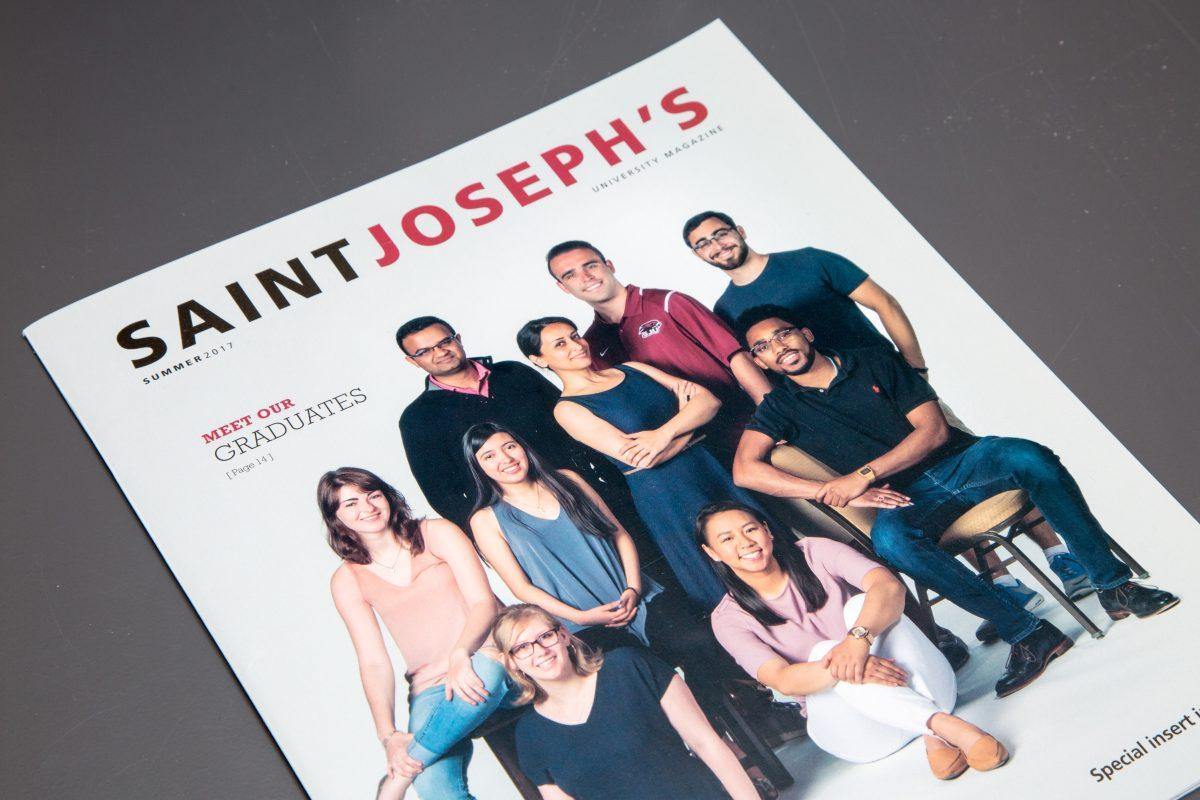Misconstrued diversity depicted at St. Joe’s
The front cover of the summer 2017 issue of the Saint Joseph’s University Magazine features a photo of nine recent university graduates.
Based on the students who appear in the photo, Hawk Hill appears to be a diverse place filled with Asian American, African American, Hispanic, Caucasian and East Asian American students.
The fall 2017 census data gathered by Bob McBride, associate provost for Enrollment Management, tells a different story about the reality of diversity on campus.
According to this data, this academic year, the new class of freshmen is 80.4 percent white leaving 19.6 percent of the class to be divided up amongst other race/ethnic groups. At 3.7 percent, the number of African American students this year has decreased from last year’s freshman class, which included 5.8 percent.
Monica Nixon, Ed.D, assistant provost for Inclusion and Diversity, said what’s even more important than these numbers is how students feel about their implications.
“Do we have a critical mass of students so that when you’re living in a residence hall, you don’t feel like you’re the only one in your hall? Or when you’re in your classes, you’re not the only one in your classes?” she asked. “I think that those are deeper questions that get to what the numbers actually feel like.”
However, minority students’ actual experience with diversity numbers is a complicated subject.
“When I first came to St. Joe’s, I was like a fish in a pond ready to explore my horizons,” said Claudine Andre ’18. “But then I started to recognize that I was aware of a certain aspect of me that I was never quite aware of until stepping into class. I didn’t realize how much of a huge impact it would have in my experience here, which it vastly did.”
Like Andre, Jai Williams ’18 had to adjust after arriving at St. Joe’s.
“When I was in high school, my school was a very diverse inner city school as opposed to St. Joe’s,” he said. “It’s different dealing with students here on a daily basis than it was dealing with my high school classmates.”
Alex Cruz ’18 found that at St. Joe’s, people have trouble seeing beyond race.
“Here you are just black or Hispanic,” he said. “People don’t really understand that you could be more than one thing.”
Recruiting students like Andre, Williams and Cruz is one of the responsibilities of James Jackson, an admissions counselor in the Office of Undergraduate Admissions who specializes in multicultural recruitment.
Jackson said the admissions team is not trying to meet quotas, they are looking for students who they believe will excel at St. Joe’s.
“When we are admitting students, we go by students who we know can do well at this university,” Jackson said.
At the same time, Jackson said the university connects with local community-based organizations, religious organizations and other cultural organizations in order to do “targeted recruiting.”
“We let them know the different types of opportunities that Saint Joseph’s can offer to underrepresented populations,” he said. “We are willing and able to accommodate those students to feel comfortable at this university.”
Jackson was not surprised by the dip in diversity of this year’s freshman class as reported by McBride’s office, and not worried. Overall, St. Joe’s diversity numbers have been “pretty consistent,” he said.
“I think it’s reflective of a lot of students starting to gravitate more towards colleges and universities that tend to have more of their ethnicity or backgrounds,” Jackson said. “If they feel like on the surface, St. Joe’s doesn’t offer that, they may not come here. That’s the barrier we’re trying to go across so that we can recruit these students.”
Student-run clubs such as the Black Student Union, the Latino Student Association, the International Student Association, SJU Pride, Women’s Leadership Initiative, the Asian Student Association, the Caribbean Student Association and Bridging the Gap welcome minority students after they arrive on campus.
With these initiatives, Williams said he believes the university is on the “right path.”
“Each year that I’ve been here, I’ve seen a growth in the minority community,” he said.
Still, Andre, Williams and Cruz all mentioned the way the university is portrayed on the cover of the magazine is a false advertisement.
“I get what they’re trying to do, but they should at least be open and honest because they don’t want students to come here and think that we are such a diverse community,” Cruz said. “ It’s not like that at all.”













































